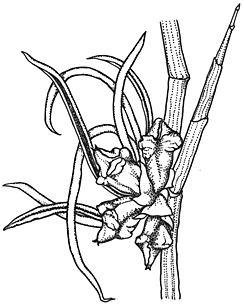Duma horrida subsp. horrida (H.Gross) T.M.Schust. APNI* Synonyms: Muehlenbeckia horrida H.Gross subsp. horrida APNI*

Description: Depauperate erect low shrub, ± intricate, 30–50 cm high, ± spiny, older stems with pale grey to dull brown, corky bark, rhizomatous.
Leaves crowded on very short lateral branches, eventually shed, linear, 1–5 cm long, ≤ 2 mm wide, apex acute, margins recurved to revolute, papery, sessile.
Flower clusters at separated nodes, flowers subsessile, usually 3–5 per cluster. Perianth in female flowers divided for a third to half of its length, strongly thickened and angular in fruiting stage, in males divided for slightly more than half its length. Anthers 0.8–1.3 mm long.
Achene trigonous, 2.0–2.5 mm long, smooth, brown.
Distribution and occurrence: Inland NSW; also Victoria and South Australia. Typically in silt in and beside dry inland lakes.
NSW subdivisions: NWP, SWP, SFWP
Other Australian states: Vic. S.A.
Leaves are sometimes attacked by an orange fungus.
Text by K.L. Wilson (1990; updated Sept 2006; Aug 2012)
Taxon concept: Flora of NSW 1 (1990)
| The single subspecies in NSW. Characters and distribution as for the species in NSW. |
APNI* Provides a link to the Australian Plant Name Index (hosted by the Australian National Botanic Gardens) for comprehensive bibliographic data
***The AVH map option provides a detailed interactive Australia wide distribution map drawn from collections held by all major Australian herbaria participating in the Australian Virtual Herbarium project.
|


